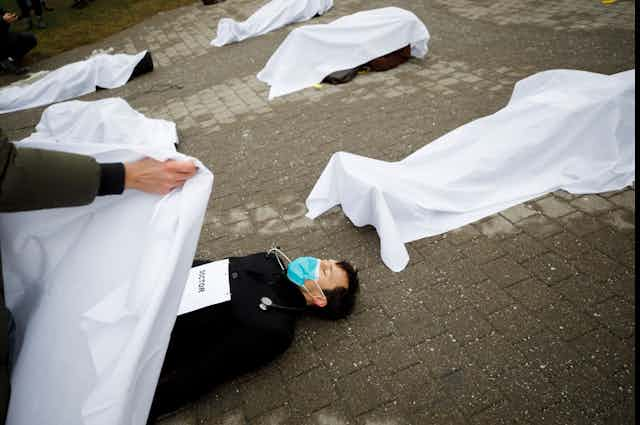Over the past year, Canada’s federal government, policy-makers and employers have made significant strides in providing temporary paid sick leave provisions related to COVID-19. But the challenges associated with workplace safety when sick leave is unpaid persist.
This requires permanent and shared solutions to protect workers, the community and the economy.
Although quarantine was mandated for people unable to work due to being exposed to COVID-19 or if they were exhibiting symptoms, working while unwell — called presenteeism — continued due to employees’ financial concerns. Although every major public health agency recommended staying at home when sick, some employees without paid sick days couldn’t afford to do so.
Read more: Employers need to give paid sick days to fight the coronavirus
Since March 2020, more than 7,900 workplace COVID-19 outbreaks have occurred. This startling figure doesn’t take into account the impact of outbreaks on health-care workers, teachers and those in group homes or shelters.
In the past 20 years, there have been at least five pandemics or serious infectious disease outbreaks: SARS in 2003, H1N1 in 2009, MERS in 2012, Ebola in 2014 and COVID-19 in 2020.
Workplaces are at particular risk of exposure to infectious diseases. Employees who come into work while waiting for test results or who feel unwell risk infecting co-workers. That means illness and outbreak containment measures require workplace solutions.
Failing our workers
Paid sick days can be mandated in government legislation, or as a workplace-specific benefit. Canada is failing its workers on both fronts. At the start of the pandemic, only employees who fell under federal, Québec or Prince Edward Island jurisdiction had legislated paid sick days, ranging from one to five days of paid leave.

Only 58 per cent of workers have access to paid sick days from their employers. Low-wage workers fare even worse — 70 per cent of people earning less than $25,000 a year lack sick day provisions from their employers.
Employers alone cannot be solely responsible for providing paid sick days. Offering 10 additional days of paid sick leave a year can translate into significant increases in labour costs.
Some businesses regard this as unaffordable. During the current pandemic, corporate revenues have largely declined and experts suggest an economic recovery could be years away.
Sharing responsibility
A feasible approach requires raising awareness of the benefits of paid sick days and for governments and employers to share responsibility.
Research shows that employees without paid sick leave are 1.5 times more likely to go to work while they’re contagious. In contrast, employees with paid sick leave are more likely to engage in routine medical care, such as receiving flu vaccines and completing annual health checks. This reduces the number of future visits to emergency departments. Providing paid sick leave to employees also significantly lowers the risk of mortality.
Reducing presenteeism is good for the business. Employees who feel unwell but can’t afford to stay home or fear they’ll lose their jobs are less likely to seek medical attention, and therefore contribute to the spread of COVID-19 or other infectious illnesses to their co-workers.

Employees who work while sick also make more mistakes and have a 28 per cent higher chance of getting injured at work. That means even longer absences, potential liability risks, decreased job performance and increased injury levels.
Employees also have a role to play, and must be held accountable if they abuse paid sick days. One in every three employees admits to calling in sick when they are healthy and well. For all employees to benefit from paid sick days, playing hooky must stop, and employers are within their rights to reprimand workers who fake illness to avoid work. This helps build much-needed accountability and fairness around paid sick days.
Supporting businesses
We also need to explore government support for businesses that implement paid sick days. Given the community health benefits associated with paid sick days and the heavy cost of the federal government’s Canada Recovery Sickness Benefit, which provides those unable to work due to COVID-19 illness or self-isolation with $500 per week for a maximum of four weeks, financial support for businesses to offer paid sick days can offset the health-care costs of outbreaks and incentivize employers.
The government’s sick leave benefit expires on Sept. 25, 2021. As of Feb. 14, there had been 392,280 unique applicants for the benefit. Assuming a $1,000 payout for a two-week absence, the paid sick day benefit has cost the federal government more than $300 million dollars in just five months. It will undoubtedly become more expensive since the government recently upped the coverage period from two weeks to four.
Ultimately, employees shouldn’t have to choose between working while sick and providing food or shelter for themselves and their families. They should also be able to go to work without fear of catching COVID-19 from co-workers.
Post-pandemic, we must learn from our mistakes and take action in a more permanent manner. While the benefits of paid sick days are clear, an integrated approach involving employers, employees and government is required.

